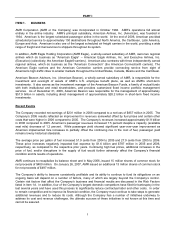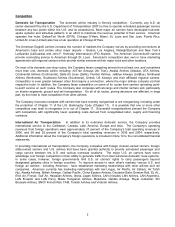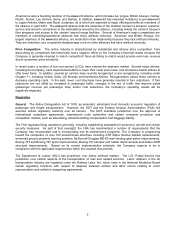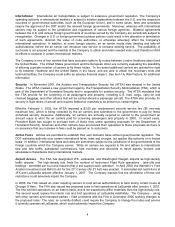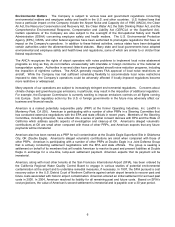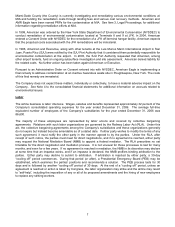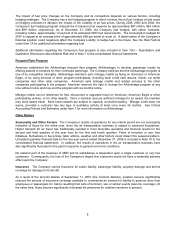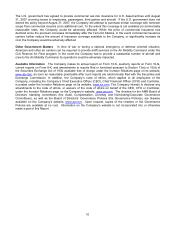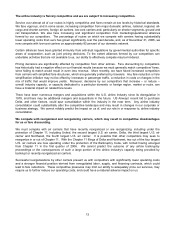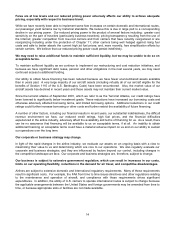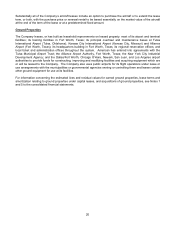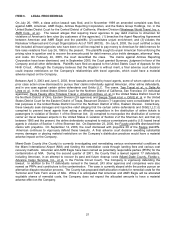American Airlines 2006 Annual Report Download - page 15
Download and view the complete annual report
Please find page 15 of the 2006 American Airlines annual report below. You can navigate through the pages in the report by either clicking on the pages listed below, or by using the keyword search tool below to find specific information within the annual report.11
ITEM 1A. RISK FACTORS
Our ability to become consistently profitable and our ability to continue to fund our obligations on an ongoing
basis will depend on a number of risk factors, many of which are largely beyond our control. Some of the factors
that may have a negative impact on us are described below:
As a result of significant losses in recent years, our financial condition has been materially weakened.
Although we earned a profit in 2006, we incurred significant losses in recent prior years: $857 million in 2005,
$751 million in 2004, $1.2 billion in 2003, $3.5 billion in 2002 and $1.8 billion in 2001. As a result, our financial
condition was materially weakened, and we remain vulnerable both to unexpected events (such as additional
terrorist attacks or a sudden spike in jet fuel prices) and to general declines in the operating environment (such as
that resulting from a recession or significant increased competition).
Our initiatives to generate additional revenues and to reduce our costs may not be adequate or
successful.
As we seek to improve our financial condition, we must continue to take steps to generate additional revenues
and to reduce our costs. Although we have a number of initiatives underway to address our cost and revenue
challenges, some of these initiatives involve changes to our business which we may be unable to implement. In
addition, we expect that, as time goes on, it may be progressively more difficult to identify and implement
significant revenue enhancement and cost savings initiatives. The adequacy and ultimate success of our
initiatives to generate additional revenues and reduce our costs are not known at this time and cannot be
assured. Moreover, whether our initiatives will be adequate or successful depends in large measure on factors
beyond our control, notably the overall industry environment, including passenger demand, yield and industry
capacity growth, and fuel prices. Given the competitive challenges we face and other factors, such as high fuel
prices, that are beyond our control, we must continue to aggressively pursue profit improvement initiatives to
achieve long-term success.
Our business is affected by many changing economic and other conditions beyond our control, and our
results of operations tend to be volatile and fluctuate due to seasonality.
Our business and our results of operations are affected by many changing economic and other conditions beyond
our control, including among others:
• actual or potential changes in international, national, regional and local economic, business and financial
conditions, including recession, inflation and higher interest rates, war, terrorist attacks or political
instability;
• changes in consumer preferences, perceptions, spending patterns or demographic trends;
• changes in the competitive environment due to industry consolidation and other factors;
• actual or potential disruptions to the air traffic control system;
• increases in costs of safety, security and environmental measures;
• outbreaks of diseases that affect travel behavior; or
• weather and natural disasters.
As a result, our results of operations tend to be volatile and subject to rapid and unexpected change. In addition,
due to generally greater demand for air travel during the summer, our revenues in the second and third quarters
of the year tend to be stronger than revenues in the first and fourth quarters of the year.
Our indebtedness and other obligations are substantial and could adversely affect our business and
liquidity.
We have and will continue to have a significant amount of indebtedness and obligations to make future payments
on aircraft equipment and property leases, and a high proportion of debt to equity capital. We may incur
substantial additional debt, including secured debt, and lease obligations in the future. We also have substantial
pension funding obligations. Our substantial indebtedness and other obligations could have important
consequences. For example, they could:


